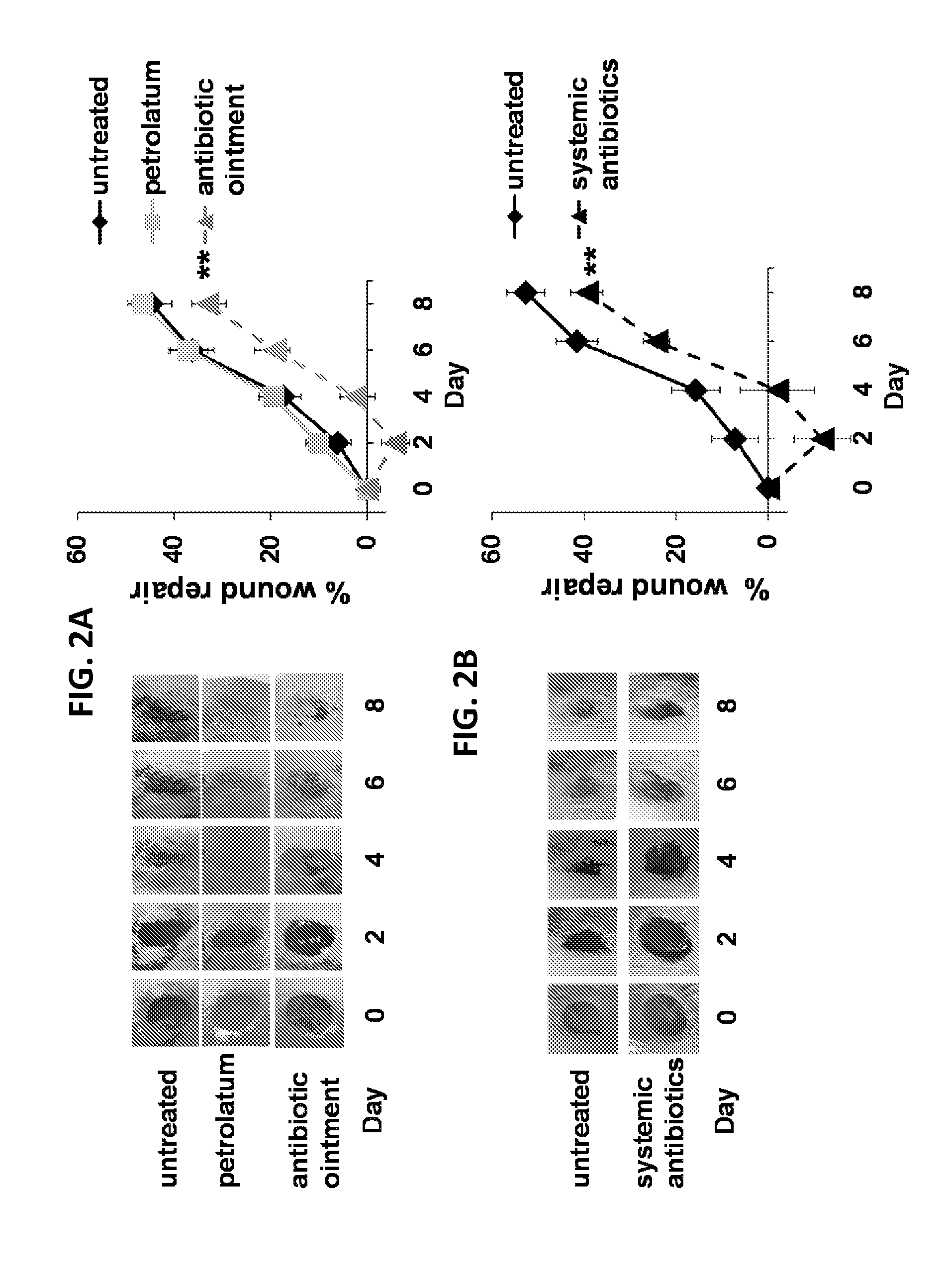Use of cpg oligonucleotides co-formulated with an antibiotic to accelerate wound healing
a technology of cpg oligonucleotides and antibiotics, applied in the field of wound healing, can solve problems such as delaying wound healing, and achieve the effect of counteracting the wound healing delay and delaying wound healing
- Summary
- Abstract
- Description
- Claims
- Application Information
AI Technical Summary
Benefits of technology
Problems solved by technology
Method used
Image
Examples
example 1
Materials and Methods
[0123]Mice: Specific pathogen free female BALB / c mice were studied at 8-12 weeks of age. Animals were monitored daily by veterinarians.
[0124]Reagents: Phosphorothioate K-type CpG ODN 1555 (sequence: GCTAGACGTTAGCGT, SEQ ID NO: 30) was synthesized and was free of endotoxin and protein contamination. Imiquimod was purchased from InvivoGen (San Diego, Calif.) riple antibiotic ointment containing 5 mg neomycin sulfate, 5000 units polymyxin B sulfate and 400 units bacitracin emulsified in one gram of white petrolatum was obtained from Fougera (Melville, N.Y.). In some studies, 5 μl of CpG ODN (10 mg / ml) and / or 5 μl IMQ (1 mg / ml) was added to 100 μl of antibiotic ointment. This formulation was then heated to 65° C. and vigorously mixed to emulsify.
[0125]Murine in vivo wound repair model: The wound repair model of Devalaraja et al (J Invest Dermatol 2000; 115: 234-44) was used. Skin on the back was shaved and treated antibiotic ointment or petrolatum. In some studies, ...
example 2
Effect of Antibiotic Treatment on Wound Healing
[0130]The effect of various concentrations of polysorbate (ranging from 1-10%) on the ability of the ODN and IMQ dissolved in water to form a stable emulsion with the liquified antibiotic ointment was tested. A ratio of 5% polysorbate:85% liquified ointment:10% TLR ligand yielded an emulsion from which the active components were slowly released (over a period of 2 days) and in a form that retained their biological activity (as well as the antibacterial activity of the ointment).
[0131]Triple antibiotic ointment containing neomycin, bacitracin and polymyxin B was applied to either the right or left dorsum of mice while antibiotic-free petrolatum (the base in which the ointment was formulated) was administered to the contralateral side. Alternatively, the broad spectrum antibiotics vancomycin and imipenem / cilastatin were injected at the base of the tail to examine the effect of systemic therapy. Bacterial levels were monitored by swabbing ...
example 3
[0133]Effect of TLR7 and TLR9 Ligands on Wound Healing
[0134]TLR ligands can accelerate wound healing in normal mice and non-human primates (see, for example, Sato et al., Wound Repair Regen 2010; 18: 586-93). It was postulated that the slowing of wound healing associated with antibiotic therapy might be reversed by co-delivering the TLR9 ligand CpG ODN and / or the TLR7 ligand imiquimod.
[0135]Preliminary studies were performed to identify the optimal method of co-administering these ligands with the antibiotic ointment. Simply applying CpG ODN or IMQ over a pre-existing layer of antibiotic ointment or petrolatum had no effect on wound healing, suggesting that their diffusion to the skin was blocked. A method for incorporating the CpG ODN and / or IMQ into the antibiotic ointment was then developed, in which the ointment was melted and vortexed together with the TLR ligand. Once cooled to room temperature (RT), the bioactivity of the antibiotic and TLR ligand were retained (FIG. 5) with ...
PUM
| Property | Measurement | Unit |
|---|---|---|
| time | aaaaa | aaaaa |
| temperature | aaaaa | aaaaa |
| temperature | aaaaa | aaaaa |
Abstract
Description
Claims
Application Information
 Login to View More
Login to View More - R&D
- Intellectual Property
- Life Sciences
- Materials
- Tech Scout
- Unparalleled Data Quality
- Higher Quality Content
- 60% Fewer Hallucinations
Browse by: Latest US Patents, China's latest patents, Technical Efficacy Thesaurus, Application Domain, Technology Topic, Popular Technical Reports.
© 2025 PatSnap. All rights reserved.Legal|Privacy policy|Modern Slavery Act Transparency Statement|Sitemap|About US| Contact US: help@patsnap.com



